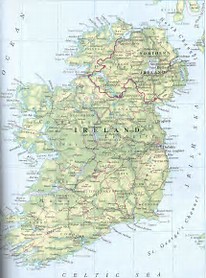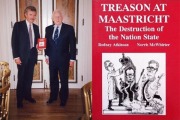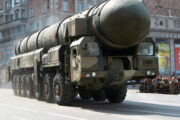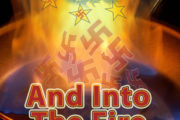by Professor Arthur Noble
The Irish were not the original inhabitants of Northern Ireland, St Patrick was not Irish, the original Irish Christianity was not Roman Catholic and the biggest ethnic cleansing in Ireland was that of Protestants from Southern Ireland. As the EU tries to meddle in Northern Ireland during the Brexit process, many victimhood myths about Irish history and religion need to be strongly countered.
When the Irish Republic continues as an EU member after Brexit, it will retain what is the only land border with the UK. The EU is illegally interfering by tempting Northern Ireland with keeping its full EU membership on condition that it abandons the UK to become part of the Republic of Ireland; but Brussels must be totally ignorant of history or – to use the phrase which it disdainfully applied to Theresa May – must itself be living in another galaxy. The Northern Ireland Protestant majority would never vote to join a united Ireland, while surveys have revealed that support for it is waning further among the Province’s Roman Catholic minority,1 and 16% of the Sinn Féin electorate would not vote in favour of it either. (2)
From the Magna Carta through the Gunpowder Plot to Hitler’s Concordat with the Vatican, British history has been a constant struggle for freedom from the domination and jurisdictional claims of the Papacy, pursued through numerous plots and in various guises, and aided and abetted by the Southern Irish Roman Catholic State. The Reformation finally won for Britain liberty of faith and conscience, freedom of expression and freedom of the press; and when the principles of the Bible regulated all our actions and legislation, unparalleled social blessings and political greatness followed. The ensuing Williamite Revolution Settlement enshrined the Constitutional principle of the Monarch as Defender of the Protestant Faith.
Developments in Europe in the 20th century were not planned to end with merely economic or even political union. The ultimate goal was already revealed in the Papal encyclicals of Pius XII and John XXIII: Europe was to become “the greatest [Roman] Catholic superstate the world has ever known”. (3) The Vatican planned to give its ecclesiastical guarantee to this new Europe, which was to be the dynamic opposite of Churchill’s post-War vision of a democratic association of nation states.
The vicious campaign of lies, terrorist violence and denigration perpetrated against Ulster’s Protestant Unionist majority during the last decade of the 20th century was part of the Vatican’s plan for its envisaged Roman Catholic Europe. The ongoing campaign is currently being reflected in the vilification of the predominately Protestant-based Democratic Unionist Party for its support of Theresa May’s Conservative government. (But when their social Conservatism was mimicked by Angela Merkel in her vote against homosexual marriage she was not condemned because her aim is also the Vatican’s – a European Superstate)
From time immemorial the campaign was based on deliberate falsification of historical fact by the two traditional enemies of Northern Ireland – Irish Nationalism and the Roman Catholic Church. The Nationalists’ concept of ‘history’, fantasised by the rich Gaelic imagination and fused with the superstitions of the Roman Catholic Church, obscured historical truth and shrouded it in an aura of mystery and mysticism which was repeated so often that it came to be believed.
Nationalists portray the history of Ulster as having begun with the so-called ‘Plantation’ in the 17th century, when so-called Protestant ‘invaders’, described as British Protestant ‘colonialists’, are portrayed as having ousted the ‘original’ religion from the Island, which they claim was Roman Catholicism.
This is double nonsense: the original faith of Ireland was the pure, unadulterated Christianity preached by St. Patrick in the 5th century – Roman Catholicism was not known in Ireland until the 12th century; and those who came to the Island from Scotland and northern England during the ‘Plantation’ were the descendants of the original inhabitants of Ulster, expelled by the Irish invaders in the third century and returning to their rightful homeland.
Dublin’s historical myth
The Irish Government has stubbornly refused to acknowledge the historical truth that the Ulster Scots, not the Irish, were the original inhabitants of Ulster. Knowledge of this truth would quickly have put an end to Irish claims to jurisdiction over Northern Ireland.
The word ‘Ulster’ is derived from the name of a British tribe called the ‘Uliti’, who were first recorded by the geographer Ptolemy on the earliest known map of the British Isles drawn in the second century A.D. The map records that other British tribes such as the Pretani, from which the term ‘Briton’ is derived, constituted the dominant population in both Ulster and northern Britain in these ancient times. Hence the name ‘British Isles’. Not one single Irish name of any feature appeared on Ptolemy’s map.
Moreover, the Romans referred to the ‘Britannic Islands’: the smaller island was called ‘Little Britain’ and the larger Island ‘Great Britain’ (the latter designation having originally nothing to do with military or other greatness). The Irish did not arrive until the third century A.D., and it was they who originally ‘colonised’ Ulster, launching an attack under Queen Maeve from their Midland Kingdom of Meath against the north-eastern Uliti, many of whom fled to Scotland from the Irish Gaels (a name which means ‘bandits’). When the Ulster Scots returned during the ‘Plantation’, they were coming back to the land from which they had been ousted by the Irish.
The Vatican’s historical myth
St. Patrick was not Irish at all. Nor was he a Roman Catholic. He was British, born about 389 AD in the Severn area and abducted as a teenager by Irish marauders, who brought him to Ireland and kept him in captivity for six years. His Confession, reflected in the Book of Armagh, also known as the Codex Ardmachanus, exposes the mythical fantasy surrounding his life. The Roman Catholic hierarchy falsely calls him the ‘Apostle of Ireland’; but Christianity had been known for at least 200 years before he landed on its shores.
The ancient unadulterated Christian faith of the island’s inhabitants – that which, arriving directly from the Holy lands, replaced their earlier heathenism – spread and flourished through Patrick’s ministry and gained for Ireland the description ‘Land of Saints and Scholars’. This faith was entirely different from Roman Catholicism.
It was not until 1152, some 700 years after Patrick, that Roman Catholicism came to Ireland, where it subsequently held undisturbed rule for almost 800 years. Those who falsely label Protestantism as the invader imposed from England need to remember that it was in fact, ironically, an English monarch, the Roman Catholic Henry II, who brought Ireland under the authority of Rome. The Report of the United Protestant Congress of 1922 (p. 102) puts the paradox succinctly: “It was a Pope who first robbed Ireland of her independence, and […] an English [Roman Catholic] invader who was the first to establish in Ireland the supremacy of Rome.”
Slaughter of Protestants
The great tragedy of the Irish has been their failure to recognise that it was not the British, but Roman Catholicism, posing as their liberator, that dragged them into centuries of spiritual servitude, social deprivation, superstition and poverty. It made the Bible a closed book in the classroom, in church and at home.
In 1641 the notorious Irish Roman Catholic rebel Phelim O’Neill (1603-1653) instigated a dreadful massacre of Protestants in Ireland because they refused to bow the knee to the Church of Rome. Through slaughter, cruelty and torture, Irish Roman Catholics attempted to exterminate all Protestants as well as every trace of British culture and influence. Protestants were hacked to death, disembowelled, burned and boiled alive, starved, drowned and frozen naked. 100,000 Protestants were slaughtered by Romanists in the great massacre of St.
Bartholomew’s Eve.
At the Battle of the Boyne in 1690 Ulster became Britain’s Protestant bastion. One of the ramparts which the forefathers of our nation built around their rights and liberties was the Revolution Settlement under King William III and his Queen Mary. It established a Protestant Throne, a Protestant Legislature and a Protestant Electorate. The 1689 Act also set the Succession of the Crown, and today Queen Elizabeth II remains the “Defender of the [Protestant] Faith”.
Irish Nationalism and Roman Catholicism
In the 1930s Roman Catholicism had become the central characteristic of Irish Nationalism and was the major influence on the shaping of the new State. The Eucharistic Congress of 1932 demonstrated the importance of the Roman Catholic religion in the celebration of the Irish national identity through the Gaelic tradition.
In 1704 the Irish establishment deliberately discriminated against Presbyterians by excluding them from public life in Ireland. After Roman Catholics obtained the franchise in 1793, they succeeded in subverting the main Protestant churches by means of the great deception of the Ecumenical Movement, which still continues today.
During the 18th century many Ulster men and women were forced to emigrate to America for religious and economic reasons.
In the colonial days of the United States the Ulster Scots played a leading role in the War of Independence, in which Southern Irish Roman Catholics were no more involved than they were in World War II, when the self-confessing ‘neutral’ Irish State was less than helpful in the fight against European Fascism and ended the war with their President De Valera signing the Dublin German Embassy’s Book of condolence on the death of Adolf Hitler! (For a more recent analysis of the continuation of Irish Fascism into the 21st century see Chapter 15 of “And into the Fire – Fascist elements in post war Europe and the development of the European Union” by Rodney Atkinson, see home page on this site or order from Amazon)
Religious Divide and Pogrom
More recent Irish history is still inextricably bound up with the religious divide between the Protestant majority of Northern Ireland and the Roman Catholic majority of the Irish Republic. When the Island was partitioned in 1921, the six Counties of Northern Ireland remained part of the United Kingdom to be governed until 1972 by what was called “a Protestant Parliament for a Protestant people”. (4) In 1922 what was at first called the Irish Free State adopted a Constitution which according to its Article 8 could not discriminate on religious grounds.
After the Nationalists obtained possession of the 26 Counties in 1921, the pogrom against Protestants continued, resembling the massacre of 1641 and the mass murder of Protestants during the 1798 Rebellion. The systematic extermination of Protestants became a contagious disease.
Within three or four years 146,000 Protestants had to flee from the new Irish State. Many more were murdered before they could manage to escape. There were 30 Orange Lodges in the city of Dublin, four District Lodges, a City Grand Lodge, Trinity College Grand Lodge, and seven Preceptories. Within a few months not a single one of them had survived.
The Irish Government commandeered the magnificent Orange Hall in Dublin and used it as a Post Office. Many Protestant churches were closed for want of a congregation; numerous others had to be amalgamated. As the 1920s progressed, the anti-Protestant sectarianism of the new State increased. A memorable instance was the attempt in 1925 to outlaw divorce – which the poet and playwright W.B. Yeats (1865-1939), who was then a member of the Irish Senate, described as “a measure which a minority of this nation considers to be grossly offensive”.
Constitution
In the 1930s Roman Catholicism had become the central characteristic of Irish Nationalism and was the major influence on the shaping of the new State. The Eucharistic Congress of 1932 demonstrated the importance of the Roman Catholic religion in the celebration of the Irish national identity through the Gaelic tradition.
The next logical step was the Republic’s infamous 1937 Constitution, personally drafted by a fanatical Roman Catholic Nationalist, Eamonn de Valera, in the spirit of a crusade against Protestantism. The Constitution described the country as “[Roman] Catholic”. It was a priest-inspired Constitution for a priest-dominated society. Its fundamentally theocratic nature, including its provision of a privileged position for the Roman Catholic Church, constitutes a breach of the formulation by the UN Commission on the Rights of Man (freedom of thought, conscience and religion) and contravenes the 1977 declaration by the UN Commission on Human Rights.
The deletion, following the 1972 referendum, of the provisions of Article 44.2-3, which granted a special position to the Roman Catholic Church, was in reality a clever confidence trick in that it also withdrew the former recognition of (without the granting of equality to) a limited number of other faiths. While the special position of the Roman Catholic Church and other named religions was removed in theory by the Fifth Amendment, in practice discrimination against Protestants not only continued, but became worse. As J.M. Kelly points out, the Roman Church still enjoys a highly privileged position under that Constitution: “While these provisions […] are no longer part of the Constitution, they […] are still part of the law. Moreover, although repealed, they may perhaps still be looked at for guidance on the on the intended sense of other provisions, or of the Constitution as a whole. (5)
Religious Bigotry and Ethnic Cleansing
A Roman Catholic priest by the name of Watson was quoted in The Spectator of 22 January 1972 for his notorious sectarian remarks directed specifically against Northern Ireland’s Protestants and the Parliament at Stormont: “How do you bring a Unionist Government to its knees unless you bomb them out? […] There are many who believe it’s the only way it can be done. […] The hierarchy’s in a mess, but in their heart of hearts they believe [IRA] violence is justified.”
The real facts reveal more than 75 years of systematic ethnic cleansing. In 1989 the influential Dublin magazine Magill printed figures showing that between the census of 1911 – the last to precede the Treaty – and 1981, the Protestant population of the 26 Counties of Southern Ireland fell by 63%. The drop until 1989 it estimated at 68%.
The causes of this dramatic decrease – from 10% in 1911 to 3.4% in 1981 and about 2.5% by the late 1980s – were listed as “alienation from the ethos of the State, emigration, and, over latter decades, mixed marriages”. The Roman Catholic Church’s decree, backed by the Courts, that children in mixed marriages must be brought up as Roman Catholics, created “social and cultural apartheid” which “more often than not, heralded the end of the line for Protestant families”.(6) The single biggest drop in Protestant numbers occurred between 1911 and 1926, when a third of the Protestant population left the State following widespread intimidation and the burning of their properties.
The stark fact remains that the Irish State has, since its inception, deliberately and methodically reduced the Protestant population from 10% to 2.5%. In the 1930s, the Nazi propaganda machine painted an idyllic picture of Germany’s Jews as a privileged minority. In his autobiography All in a Life (1991), former Irish Prime Minister Garret FitzGerald wrote: “If I were a Northern Protestant today, I cannot see how I could be attracted to getting involved with a State that is itself sectarian. […] It would be a waste of time to talk about changing the Constitution so as to make it acceptable to unionists. […] A reflection of the [Roman] Catholic ethos in our legislation was ‘quite natural and what you would expect’. (7)
Dr. FitzGerald’s subsequent ludicrous image of Southern Protestants as a “privileged minority” needs to be rectified by the accurate description given by Jack White in his book Minority Report (1975): “a minority without privilege”.
A major book by Robin Bury, Buried Lives: The Protestants of Southern Ireland, recounts in detail many of the personal stories of Protestants affected by the lawlessness against them, including the numerous murders, disappearances, evictions, intimidation, arson, land seizures, looting and boycotting, and tells a sad story of the clear sectarian nature of often unreported systematic ethnic cleansing in the Irish Republic. (8) Many of them included disbanded members of the former Royal Irish Constabulary, British ex-servicemen, and civilians loyal to the British regime in Ireland. Some 60,000 Protestants, not connected to the administration, left in the period 1911-1926. Bury notes that practically the whole of the Protestant working-class – perhaps 10,000 – fled from Dublin in the early 1920s. Similar tactics were used by the IRA towards the end of the 20th century in its campaign of bombings, killings and ethnic cleansing of Protestants in Northern Ireland.
Ninety percent of the 3,200 primary schools in the Irish Republic are under the patronage of the Roman Catholic Church and are permitted by law to prioritise the enrolment of baptized Roman Catholic children. On 6 August 2015 even the Republic’s own Minister of Education, Ruairi Quinn, called for the ending of this monopoly, pointing out that the country has already been found by the United Nations human rights bodies to be in breach of undertakings and treaties which the Irish State signed voluntarily.
Terror
The Protestants of Northern Ireland have not been deceived by the sham ‘removal’ of Articles 2 and 3 from the Irish Constitution following the 1998 Referendum in the Republic, which merely substituted a claim of nationality for a claim of territory and jurisdiction, and even provided for the alteration to be rescinded should circumstances require it.
They remember the inflexible position of the author of the Irish Constitution, Eamonn De Valera, who said in 1918 that the “rock of Ulster Unionism must be blasted out of [the Nationalists’] path”, and who told Chamberlain in 1938 that if Ulster stood in the way of the attainment of Irish unity, then “the coercion of Northern Ireland would in all circumstances be justifiable”. De Valera also signed the book of condolences on the death of Adolf Hitler. Two of his close associates made memorable pronouncements on Ulster’s Protestant population: O’Duffy (President of the United Ireland Party and later Chief of Staff of the official Southern forces), said: “Give them the lead [leash or whip]”; and Corry: “Let poison gas be used on them.” (9)
(“General” Eoin O’Duffy – a title he was given by Franco – took the “Irish Brigade” to fight for the Fascists in the Spanish Civil War).
That goal has been pursued and intensified into the present through the campaign of terror waged against Ulster’s Protestant majority by the IRA. The bombing of Protestant towns, the burning of Protestant churches, the contrived re-routing of Loyalist marches, the banning of the playing of the UK National Anthem at Queen’s University – all have proved to be part of an attempt to expunge every facet of the Protestant heritage, culture and identity and are a foretaste of how Protestants would be treated in a united Ireland. Yet the perpetrators are transubstantiated into peacemakers, while Irish Nationalism as a whole has come to speak with the same voice as its terrorist front men.
Just a few contemporary examples
On 1 March 1992 the Dublin newspaper Sunday World reported on the systematic victimisation of a Christian couple by gangs of youths in Cork because of their religious beliefs and for preaching the Gospel in the city and country towns. The husband was shot through the head for preaching in the street, but survived.
In April 1995 numerous Protestant church buildings were attacked and burned: one in County Wicklow was daubed with IRA slogans written in human blood, ransacked, and set alight. Only the Bible failed to burn. The Republic’s press teemed at the time with reports of physical attacks on Dr. FitzGerald’s allegedly “privileged” and “endowed” Protestant minority. More than 40 attacks a week were being perpetrated on their persons, businesses, homes and property.
In 2008, when the Irish Government moved to abolish the support grants for around 20 Protestant-managed fee-paying schools because of their non-Catholic status and save €2m, the Principal of Sligo Grammar School accused the Irish Education Minister of a policy of savage cuts and deliberate discrimination against Protestant schools, aimed without any consultation at diluting their minority even further. (10)
In 2014 a spate of violent incidents against Protestants over a wide geographical area of the Irish Republic, including aggravated burglaries and the vandalising of Protestant churches, was described by Church of Ireland minister Rev. David Crooks as having been perpetrated by the “scum of the earth”. (11)
The Irish Sunday Times of 2 August 2015 reported that a four-year-old boy in Dublin had been refused a place at several local primary schools because he is not a Roman Catholic or a member of any of the religious groups mentioned in the Irish Constitution.
As I was preparing this article, a Protestant acquaintance from overseas who (fleeing one of those hell holes whose persecutions the MSM sanitise or censor) recently settled in the Irish Republic. There he was physically threatened and told to leave the Irish Republic when a Bible was discovered on his bedside table in his rented lodgings. He fled to Northern Ireland where he has since set up a thriving business.
FOOTNOTES
1 http://www.thejournal.ie/waning-support-for-united-ireland-among-northern-catholics-157651-Jun2011/
2 Statistics supplied by Rodney Atkinson
3 https://www.tomorrowsworld.org/magazines/2003/september-october/europe-and-the-vatican-agenda; emphasis mine
4 https://en.wikipedia.org/wiki/A_Protestant_Parliament_for_a_Protestant_People
5 J.M. Kelly: The Irish Constitution. Dublin 1980, p. 537
6 “Discrimination in Eire”, The Magill Magazine, February 1989
7 https://www.goodreads.com/book/show/2077349.All_in_a_Life
8 https://www.amazon.co.uk/d/Books/Buried-Lives-Protestants-Southern-Ireland-Robin-Bury/1845888804; Kindle edition £6.99
9 Quoted in Hugh Shearman: Anglo-Irish Relations, London, Faber and Faber, p. 204
10 The Irish Independent, 25 October 2008
11 The Irish News, 8 February 2014


















